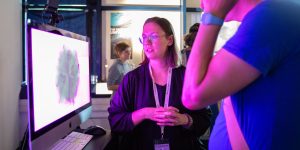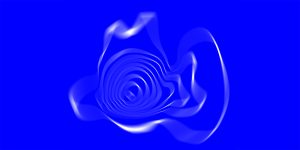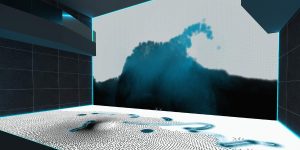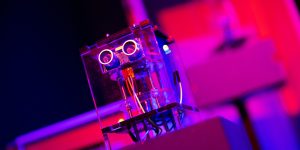Environment

Lucky Island
Michaela Lautenschlager (DE)
Outside our visible spectrum of light, there is a very big area of electromagnetic radiation. Scientifically, that is also light, as it consists of photons. The most dangerous part for the human being: gamma rays. They are characterized by a very small wavelength and permeate almost all materials on earth. We cannot see them and generally only notice them when they are linked to radioactivity; for example, when we deal with the consequences of atomic bombs and nuclear accidents in power plants. In this project I don't want to downplay the dramatic effects of being exposed to this radiation but I want to help people understand it better. Therefore, I used the principle of sonification to make live measurements of monitoring stations in Japan “audible.”

Color Impression
Lukas Woerm (DE)
Light. Light is boundless and dematerialized – it is intangible and enables our primary perception, seeing. A contourless, monotone space filled with light forces our brain to cope for a short time without this visual input. Orientation and lack of dimension are the consequences. Light, color and space become one. A non-objective environment makes human perception the object of contemplation. How is our emotional being influenced by light and colors?

Anti Conductor
Ryo Kishi (JP)
Anti Conductor embraces the beauty of struggles. In our society, individuals tend to go with the flow of their environment. It’s human nature because it’s easier to survive. But it’s also monotonous and boring. If no one tries to go against the flow, nothing is going to change. The image of an individual struggling in the flow is full of power and energy, even if their efforts might not pay off.
PRESSURE
Julian Pixel Schmiederer (AT), Gregor Franz (AT), Johannes Rass (AT), Lara Rabitsch (AT)
The movie is a mirror of modern society where uniqueness is demonized, where striving for freedom is something uncommon and where chasing your dreams is not cool anymore. In a society like this it´s hard for people to identify themselves, because we are taught not to be different. We are always trying to push our psychological limits to the edge, just to do what others think is good for us. The film is dealing with these issues and looks at them from an artistic perspective.

Liquidus
Roman Divotkey (AT), Nora Loimayr (AT), Christoph Schaufler (AT), Wolfram Weingartner (AT)
*Liquidus* is an interactive, physics-based fluid simulation that turns Deep Space into a playful laboratory to experiment with various properties of liquids and gases. Data for the physics calculations are processed and visualized in real-time and are also utilized to create a soundscape that supports the overall visual experience.

Humus, Humanity & Humility
Julian Chollet (DE)
Humus is more important than art, money, or success. Humanity depends on intact ecosystems and fertile soil. Humility and responsibility will help our species survive.

30°
Mathias Foot (DE), Franziska Rast (DE), Stephan Schakulat (DE)
Covering 71% of the Earth’s surface, water is an important part of the global ecosystem. Every development and change in the sea also affect life on earth. Datasets help us to understand conditions and ecological processes such as changes in salinity or temperature. 30° is a data visualization of marine data in the form of an installation.

The Earth that Is Us
Bruno Gomes (BR), Karapotó Plak-ô Indigenous community, Alagoas (BR)
An extension of the concept of body painting with the use of technology that opens the door to new experiences and new conversations. Participants drew the elements present in their natural environment which were then animated and projected onto their bodies.

Sounds, and sweet airs
Kornbongkoch Harnpinijsak (TH), Weichen Tang (CN), Nong Hua Lim (MY)
This sensory design project reflects on natural sound ecologies to create a synthetic environment around human-technology interaction. It encourages us to rethink our relationship with the environment.

The Hidden Life of an Amazon User
Joana Moll (ES)
“The Life, Lessons & Rules for Success of Jeff Bezos” was purchased at Amazon on June 17, 2019. In order to purchase the book, the customer was forced to go through 12 different interfaces made of large amounts of code, adding up to 87.33Mb of data. The piece narrates the journey within the labyrinth of interfaces and code that allowed them to buy the book, while revealing the mounting energy costs unwittingly paid for by the Amazon customer.


